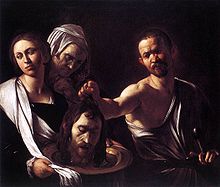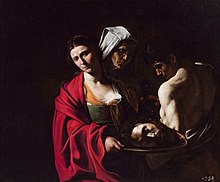The Beheading of John the Baptist (Caravaggio)
The Beheading of John the Baptist is an oil painting by the Italian artist Caravaggio . According to Andrea Pomella, the work is widely recognized as Caravaggio's masterpiece and “one of the most important works of Western painting”.
composition
The picture shows the execution of John the Baptist , Salome stands close by with a golden bowl, ready to receive his head. Another woman, possibly Herodias , who realizes that the execution was a mistake, stands by in shock while a jailer gives instructions and the executioner performs the beheading with a dagger. The representation, which is less inspired by the Bible than by the Legenda aurea , is found more frequently by Italian artists and also by Caravaggio.
It is the only signed work by Caravaggio. The signature is in the blood that flows from John's neck. There is a lot of free space in the picture, but due to the enormous size of the canvas, the figures are roughly life-size.
After John Varriano, Caravaggio took the background for his picture from the depiction of a prison in the Criminal Code of the Knights of Malta . As is characteristic of Caravaggio's later works, the number of props and their representation is minimal.
history
The painting, made in Malta in 1608 , was commissioned by the Knights of Malta for an altarpiece. It is the largest altarpiece that Caravaggio painted. It hangs in St. John's Co-Cathedral , for which it was made and where Caravaggio was also introduced as a knight and worked briefly.
Caravaggio's job was short and difficult as he was on the run after escaping prison after an unsolved crime.
The exclusion of Caravaggio in absentia as a “rotten and stinking rascal” from the order, only about six months after its introduction, took place in the chapel with this picture.
Caravaggio created several works that depict the moment after this event. One of them is in the National Gallery of London ; the other in the Palacio Real in Madrid. It is believed that one of the two is the picture with which Caravaggio wanted to appease Alof de Wignacourt , the Grand Master of the Knights of Malta who had expelled him. But that cannot be proven.
The image was badly damaged during restoration work ahead of a major exhibition in Rome in the 1950s. Caravaggio's signature was also discovered during the restoration. However, this is a source of disagreement. Genevieve Warwick claims that the work f. Michelang.o (f. To indicate his membership in the order), but the more common view is that Caravaggio signed “I, Caravaggio, did it”, as an admission of a crime - perhaps in connection with the death of Ranuccio Tomassoni, because of him the painter fled from Rome.
Individual evidence
- ^ A b Michelangelo Merisi da Caravaggio, Andrea Pomella: Caravaggio: an artist through images . ATS Italia Editrice, Rome 2005, ISBN 88-88536-62-0 , p. 106 ( books.google.de ).
- ^ Ann Sutherland Harris: Seventeenth-century Art and Architecture . Laurence King Publishing, London 2005, ISBN 1-85669-415-1 , pp. 49 ( books.google.com ).
- ↑ a b c Simon Gaul: Malta, Gozo and Comino . 4th edition. New Holland Publishers, London 2007, ISBN 978-1-86011-365-9 , pp. 109 ( books.google.com ).
- ^ Howard Hibbard: The Caravaggio: Reflections on Political Change and the Clinton Administration . Westview Press, Boulder, Colorado 1983, ISBN 0-06-430128-1 , pp. 228 ( books.google.com ).
- ^ A b Ingrid Drake Rowland: From Heaven to Arcadia: The Sacred and the Profane in the Renaissance . New York Review of Books, New York 2005, ISBN 1-59017-123-3 , pp. 163 ( books.google.com ).
- ^ Howard Hibbard: The Caravaggio: Reflections on Political Change and the Clinton Administration. P. 232.
- ↑ John L. Varriano: Caravaggio: The Art of Realism . Penn State Press, University Park, Pa. 2006, ISBN 0-271-02717-7 , pp. 116 ( books.google.com ).
- ↑ John L. Varriano: Caravaggio: The Art of Realism. P. 125.
- ↑ John L. Varriano: Caravaggio: The Art of Realism. Pp. 74, 116.
- ↑ a b James Patrick: Renaissance and Reformation: Agincourt, Battle of Dams and drainage . Marshall Cavendish, New York 2007, ISBN 978-0-7614-7651-1 , pp. 194 ( books.google.com ).
- ^ Genevieve Warwick, Michelangelo Merisi da Caravaggio: Caravaggio: Realism, Rebellion, Reception . University of Delaware Press, Newark, De. 2006, ISBN 0-87413-936-8 , pp. 30 ( books.google.com ).
- ^ Howard Hibbard: The Caravaggio: Reflections on Political Change and the Clinton Administration. P. 249.
- ^ Rose-Marie Hagen, Rainer Hagen: What Great Paintings Say . Taschen, Cologne / New York 2003, ISBN 3-8228-2100-4 , pp. 216 ( books.google.com ).
- ^ Howard Hibbard: The Caravaggio: Reflections on Political Change and the Clinton Administration. P. 230.
- ^ Graham L. Hammill: Sexuality and Form: Caravaggio, Marlowe, and Bacon . University of Chicago Press, Chicago 2002, ISBN 0-226-31519-3 , pp. 95 ( books.google.com ).
- ^ Genevieve Warwick, Michelangelo Merisi da Caravaggio: Caravaggio: Realism, Rebellion, Reception. P. 15.
- ^ William Pencak: The Films of Derek Jarman . McFarland, Jefferson, NC 2002, ISBN 0-7864-1430-8 , pp. 70 ( books.google.com ).
- ↑ Christopher Peachment: Caravaggio: A Novel . Macmillan, New York 2003, ISBN 0-312-31448-5 , pp. 168 ( books.google.com ).
- ^ Earl Jackson Jr: Strategies of Deviance: Studies in Gay Male Representation . Indiana University Press, Bloomington: Indiana 1995, ISBN 0-253-11523-X , pp. 81 ( books.google.com ).


